La Fontaine Park
| La Fontaine Park Parc La Fontaine | |
|---|---|
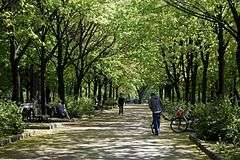 | |
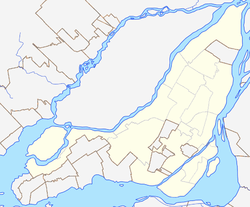 Location of La Fontaine Park in Montreal | |
| Location | Le Plateau-Mont-Royal, Montreal, Quebec, Canada |
| Coordinates | 45°31′36″N 73°34′08″W / 45.52666°N 73.56889°WCoordinates: 45°31′36″N 73°34′08″W / 45.52666°N 73.56889°W[1] |
| Area | 34 hectares (84 acres)[2] |
| Operated by | City of Montreal |
La Fontaine Park (French: Parc La Fontaine) is a 34 ha (84 acres) urban park located in the borough of Le Plateau-Mont-Royal in Montreal, Quebec, Canada. Named in honour of Louis-Hippolyte Lafontaine, The park's features include two linked ponds with a fountain and waterfalls, the Théâtre de Verdure open-air venue, the Calixa-Lavallée cultural centre, a monument to Adam Dollard des Ormeaux, playing fields and tennis courts.[3]
Its outdoor swimming pools are a popular attraction during Montreal's hot summers, with outdoor ice skating in winter. Bike paths run along the park’s western and northern edges.
Parc Lafontaine is surrounded by Sherbrooke Street on the South, Parc-La Fontaine Avenue on the West, Rachel Street on the North, and Papineau avenue on the East.[4]
History
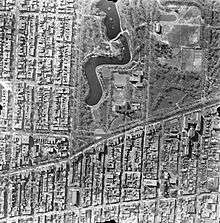
La Fontaine Park (formerly Logan Park) is located on the grounds of the old Logan farm.[5] This land was sold in 1845 to the Government of Canada, which then used it for military practice until 1888.[5][6][3] The soldiers of the British garrison housed there and were trained in the surrounding wilderness.[7]
The City of Montreal rented part of the Logan farm to create a park that was inaugurated in 1874 under the name "Logan Park". In 1888, the park underwent its first major landscaping work. It was part of the first phase of the development of the city's large nature parks, which also included Mount Royal and St. Helen's Island. Two years later, the greenhouses from Viger Square were moved to the park. This is where all the flowers that adorn the city were grown, until 1952.
In 1900, the city dug two basins at different levels, in the center of the park. They were separated by a waterfall over which the French landscape architect Clovis Degrelle built a bridge.
Occupying increasing importance to the Francophone population, Logan Park was renamed La Fontaine Park, in 1901, at the time of the Saint-Jean-Baptiste Day parade. The park was named not for its famous fountain, but instead to honor the memory of Louis-Hippolyte Lafontaine, the first francophone prime minister of the Province of Canada.
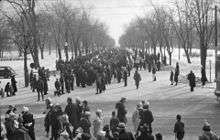
Three years later, the city expropriated homes on the city block and in the park. In 1909, the federal government donated almost all of the western section.
The illuminated fountain, which was designed by Léon Trépanier and commissioned by the Westinghouse Electric Company, was erected in the north basin in 1929. At the same time, the monument in honor of Louis-Hippolyte Lafontaine was installed.
A few years later, under the direction of Claude Robillard, the director of the Municipal Parks Service, La Fontaine Park was completely redesigned. This also marked the beginning of the construction of the chalet restaurant according to the plans by architect Donat Beaupré (the previous chalet had been destroyed by fire in 1944). The new building is part of an overall plan which includes a central pavilion, a conch for symphony concerts, an amphitheater with a capacity of 4,000 seats, a new bridge and a modification of the two ponds. The greenhouses, caretaker's house, the waterfall and the Grenelle-built bridge were demolished. In 1953 the chalet restaurant was opened by the Mayor of Montreal, Camillien Houde.
The Théâtre de Verdure was inaugurated on 8 July 1956. This was also built by Claude Robillard, and was intennded to host outdoor theatrical performances inspired by ancient amphitheatres. In 1965, under the direction of Germaine Dugas, the theatre produced many singers, including among others, Clémence DesRochers, Raymond Lévesque, Pauline Julien and Yvon Deschamps. For over 50 years, the outdoor theatre offered, free cultural programming in a natural setting.
For many years the park also hosted the "Garden of Wonders" (French: Jardin des merveilles), a small urban zoo built by the city, which opened on July 5, 1957. The garden closed in 1989. Its buildings were inspired by fables and tales, it had farm animals and other more exotic animals, including its sea lions.
Beautification works were initiated in the park in 1990: a new pathway leads visitors to a lookout above the upper pool, while a second lookout, where the works of Michel Goulet can be observed, dominates the lower pond in the axis of Roy Street. The statues of Charles de Gaulle and Félix Leclerc were installed. In 1992, the park came under full legal ownership of the City of Montreal.
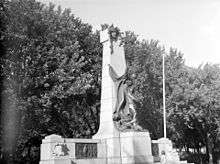
The park is occupied by many buildings such as the École supérieure du Plateau and Calixa Lavallée pavilion. Over the years, many monuments were added, such as the one dedicated to Adam Dollard des Ormeaux (1920) .
Today, La Fontaine Park continues to host the Théâtre de Verdure and the Espace La Fontaine cultural café.
Monuments
- Statue in honour of Adam Dollard des Ormeaux, created by sculptor Alfred Laliberté and the architect Alphonse Venne (Inaugurated on June 24, 1920).[8]
- Statue in honour of the former Prime Minister of the Province of Canada, Louis-Hippolyte Lafontaine (inauguration summer 1930)
- Statue in honour of Quebec writer Félix Leclerc (inaugurated in 1990).
- Statue in honour of French President and General Charles de Gaulle (inaugurated in 1990).
References
- ↑ "Parc La Fontaine". Commission de toponymie du Québec. Retrieved 25 September 2013.
- ↑ "La Fontaine park". Network of large parks. Ville de Montréal. Retrieved 25 September 2013.
- 1 2 Ulysses Travel Guides (1 March 2003). Canada 2002. Ulysses Travel Guides. pp. 179–. ISBN 978-2-89464-476-8.
- ↑ Ulysses Travel Guides; Ulysses Travel Guides Staff (1 March 2004). Montreal. Ulysses Travel Guides. pp. 246–. ISBN 978-2-89464-692-2.
- 1 2 Caroline Andrew; Beth Moore Milroy (1 November 2011). Life Spaces: Gender, Household, Employment. UBC Press. pp. 68–. ISBN 978-0-7748-4314-0.
- ↑ Montréal à l'encre de tes lieux. Québec Amerique. 2008. pp. 194–. ISBN 978-2-7644-2271-7.
- ↑ Michael John Laekas (May 2010). Mary and John: The Early Years. Gervais-Laekas Services. pp. 14–. ISBN 978-0-9865703-4-6.
- ↑ "Fonds Comité du monument Dollard des Ormeaux . - 1910-1920". Description. Bibliothèque et Archives nationales du Québec. Retrieved 11 September 2013.
External links
| Wikimedia Commons has media related to Lafontaine Park. |